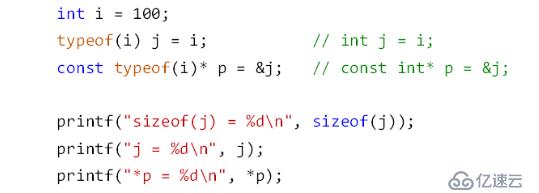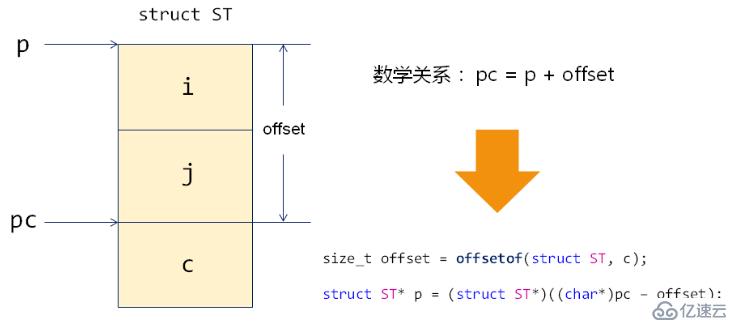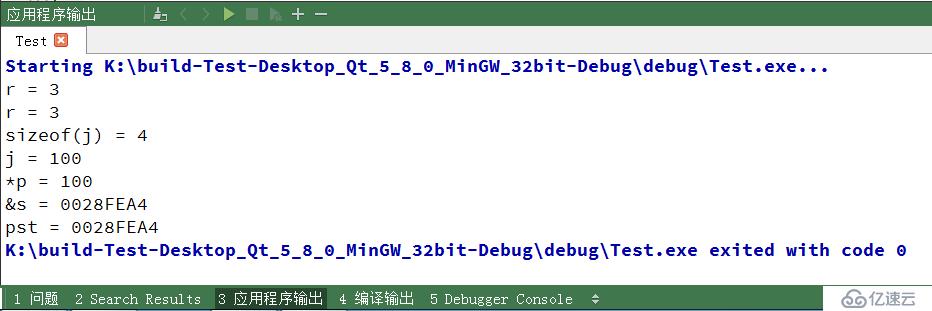жӮЁеҘҪпјҢзҷ»еҪ•еҗҺжүҚиғҪдёӢи®ўеҚ•е“ҰпјҒ
д»ҠеӨ©жҲ‘们жқҘзңӢзңӢ Linux дёӯзҡ„дёӨдёӘз»Ҹе…ёзҡ„е®Ҹпјҡoffsetof дёҺ container_ofгҖӮдёӢжқҘжҲ‘们е…ҲжқҘзңӢзңӢе®ғ们дёӨдёӘзҡ„е®Ҹе®ҡд№үпјҢеҰӮдёӢ
#ifndef offsetof
#define offsetof(TYPE, MEMBER) ((size_t)&((TYPE*)0)->MEMBER)
#endif
#ifndef container_of
#define container_of(ptr, type, member) ({ \
const typeof(((type*)0)->member)* __mptr = (ptr); \
(type*)((char*))__mptr - offsetof(type, member); })
#endifиҰҒжғізңӢжҮӮиҝҷдёӨдёӘе®ҸпјҢжҲ‘们е°ұе…ҲжқҘзңӢзңӢзј–иҜ‘еҷЁеҒҡдәҶд»Җд№Ҳпјҹ offsetof жҳҜз”ЁдәҺи®Ўз®— TYPE з»“жһ„дҪ“дёӯ MEMBER жҲҗе‘ҳзҡ„еҒҸ移дҪҚзҪ®гҖӮзј–иҜ‘еҷЁжё…жҘҡзҡ„зҹҘйҒ“з»“жһ„дҪ“жҲҗе‘ҳеҸҳйҮҸзҡ„еҒҸ移дҪҚзҪ®пјҢйҖҡиҝҮз»“жһ„дҪ“еҸҳйҮҸйҰ–ең°еқҖдёҺеҒҸ移йҮҸе®ҡдҪҚжҲҗе‘ҳеҸҳйҮҸгҖӮдёӢжқҘжҲ‘们йҖҡиҝҮжөӢиҜ•д»Јз ҒжқҘиҝӣиЎҢиҜҙжҳҺ
#include <stdio.h>
#ifndef offsetof
#define offsetof(TYPE, MEMBER) ((size_t)&((TYPE*)0)->MEMBER)
#endif
struct ST
{
int i; // 0
int j; // 4
char c; // 8
};
void func(struct ST* pst)
{
int* pi = &(pst->i); // 0
int* pj = &(pst->j); // 4
char* pc = &(pst->c); // 8
printf("pst = %p\n", pst);
printf("pi = %p\n", pi);
printf("pj = %p\n", pj);
printf("pc = %p\n", pc);
}
int main()
{
struct ST s = {0};
func(&s);
func(NULL);
printf("offset i: %d\n", offsetof(struct ST, i));
printf("offset j: %d\n", offsetof(struct ST, j));
printf("offset c: %d\n", offsetof(struct ST, c));
return 0;
}жҲ‘们жқҘзңӢзңӢз»“жһң

жҲ‘们зңӢеҲ° pst е’Ң pi жү“еҚ°зҡ„ең°еқҖеҖјжҳҜдёҖж ·зҡ„пјҢJ е’Ң c еҲҶеҲ«еҠ 4гҖӮд»Ҙ NULL дёәеҸӮж•°дј иҝӣеҺ»жӣҙеҠ зңӢзҡ„жҳҺжҳҫпјҢиҖҢзӣҙжҺҘи°ғз”Ё offsetof е®ҸпјҢе®ғзҡ„ж•Ҳжһңе’Ң NULL жҳҜдёҖж ·зҡ„гҖӮз”ұжӯӨпјҢе®ғзҡ„дҪңз”Ёе°ұжҳҫиҖҢжҳ“и§ҒдәҶпјҢз”ЁдәҺиҺ·еҸ– TYPE з»“жһ„дҪ“дёӯзҡ„ MEMBER зҡ„еҒҸ移йҮҸгҖӮ
дёӢжқҘжҲ‘们жқҘзңӢзңӢ container_of е®ҸпјҢйҰ–е…Ҳи®Іи§ЈдёӢпјҲ{ }пјүпјҢе®ғжҳҜ GNU C зј–иҜ‘еҷЁзҡ„иҜӯжі•жү©еұ•пјҢе®ғдёҺйҖ—еҸ·иЎЁиҫҫејҸзҡ„дҪңз”Ёзұ»дјјпјҢз»“жһңдёәжңҖеҗҺдёҖдёӘиҜӯеҸҘзҡ„еҖјгҖӮеҰӮдёӢжүҖзӨә

typeof жҳҜ GNU C зј–иҜ‘еҷЁзү№жңүзҡ„е…ій”®еӯ—пјҢе®ғеҸӘеңЁзј–иҜ‘еҷЁз”ҹж•ҲпјҢз”ЁдәҺеҫ—еҲ°еҸҳйҮҸзҡ„зұ»еһӢгҖӮз”Ёжі•еҰӮдёӢ

жңҖеҗҺзҡ„еҺҹзҗҶеҰӮдёӢеӣҫжүҖзӨә

дёӢжқҘжҲ‘们жқҘзј–зЁӢиҝӣиЎҢеҲҶжһҗиҜҙжҳҺ
#include <stdio.h>
#ifndef offsetof
#define offsetof(TYPE, MEMBER) ((size_t)&((TYPE*)0)->MEMBER)
#endif
#ifndef container_of
#define container_of(ptr, type, member) ({ \
const typeof(((type*)0)->member)* __mptr = (ptr); \
(type*)((char*)__mptr - offsetof(type, member)); })
#endif
#ifndef container_of_new
#define container_of_new(ptr, type, member) ((type*)((char*)(ptr) - offsetof(type, member)))
#endif
struct ST
{
int i; // 0
int j; // 4
char c; // 8
};
void method_1()
{
int a = 0;
int b = 0;
int r = (
a = 1,
b = 2,
a + b
);
printf("r = %d\n", r);
}
void method_2()
{
int r = ( {
int a = 1;
int b = 2;
a + b;
} );
printf("r = %d\n", r);
}
void type_of()
{
int i = 100;
typeof(i) j = i;
const typeof(j)* p = &j;
printf("sizeof(j) = %d\n", sizeof(j));
printf("j = %d\n", j);
printf("*p = %d\n", *p);
}
int main()
{
method_1();
method_2();
type_of();
struct ST s = {0};
char* pc = &s.c;
int e = 0;
int* pe = &e;
struct ST* pst = container_of(pc, struct ST, c);
printf("&s = %p\n", &s);
printf("pst = %p\n", pst);
return 0;
}жҲ‘们жқҘзј–иҜ‘зңӢзңӢз»“жһң

зј–иҜ‘зҡ„ж—¶еҖҷжҠҘдәҶ 4 дёӘиӯҰе‘ҠпјҢдҪҶжҳҜдёҚеҪұе“ҚжҲ‘们зҡ„иҫ“еҮәпјҢзңӢзңӢиҝҗиЎҢз»“жһң

дёҠйқўзҡ„дёӨдёӘиҫ“еҮә r зҡ„еҖјжҳҜдёҖж ·зҡ„пјҢе®ғ们зҡ„еҶҷжі•жҳҜзӯүд»·зҡ„гҖӮз”Ё container_of е®Ҹи°ғз”Ёзҡ„ж—¶еҖҷпјҢs е’Ң pst зҡ„ең°еқҖеҖјжҳҜдёҖж ·зҡ„гҖӮйӮЈд№ҲжҲ‘们用иҮӘе·ұе®ҡд№үзҡ„ container_of_new е®ҸжқҘи°ғз”Ё pe иҜ•иҜ•е‘ўпјҹзңӢзңӢз»“жһң

зј–иҜ‘зҡ„ж—¶еҖҷе·Із»Ҹз»ҷеҮәиӯҰе‘ҠдәҶпјҢиҜҙ pc зҡ„зұ»еһӢжҳҜдёҚеҜ№зҡ„гҖӮ然еҗҺжҲ‘们жқҘиҝҗиЎҢзңӢзңӢз»“жһң

жҲ‘们еҸ‘зҺ°жңҖеҗҺжү“еҚ°зҡ„ s е’Ң pst зҡ„еҖјз«ҹ然жҳҜдёҚдёҖж ·зҡ„гҖӮз”ұжӯӨеҸҜд»ҘзңӢеҮәпјҢеҺҹз”ҹзҡ„ container_of е®ҸеҶҷжі•иҷҪ然еӨҚжқӮзӮ№пјҢдҪҶжҳҜе®ғзҡ„е®үе…ЁжҖ§жҳҜжңҖй«ҳзҡ„гҖӮйҖҡиҝҮд»ҠеӨ©еҜ№ offsetof дёҺ container_of е®Ҹзҡ„еү–жһҗпјҢжҖ»з»“еҰӮдёӢпјҡ1гҖҒзј–иҜ‘еҷЁжё…жҘҡзҡ„зҹҘйҒ“з»“жһ„дҪ“жҲҗе‘ҳеҸҳйҮҸзҡ„еҒҸ移дҪҚзҪ®пјӣ2гҖҒ({ }) дёҺйҖ—еҸ·иЎЁиҫҫејҸзұ»дјјпјҢз»“жһңдёәжңҖеҗҺдёҖдёӘиҜӯеҸҘзҡ„еҖјпјӣ3гҖҒtypeof еҸӘеңЁзј–иҜ‘жңҹз”ҹж•ҲпјҢз”ЁдәҺеҫ—еҲ°еҸҳйҮҸзҡ„зұ»еһӢпјӣ4гҖҒcontainer_of дҪҝз”Ё ({ }) иҝӣиЎҢзұ»еһӢзҡ„е®үе…ЁжЈҖжҹҘгҖӮ
е…ҚиҙЈеЈ°жҳҺпјҡжң¬з«ҷеҸ‘еёғзҡ„еҶ…е®№пјҲеӣҫзүҮгҖҒи§Ҷйў‘е’Ңж–Үеӯ—пјүд»ҘеҺҹеҲӣгҖҒиҪ¬иҪҪе’ҢеҲҶдә«дёәдё»пјҢж–Үз« и§ӮзӮ№дёҚд»ЈиЎЁжң¬зҪ‘з«ҷз«ӢеңәпјҢеҰӮжһңж¶үеҸҠдҫөжқғиҜ·иҒ”зі»з«ҷй•ҝйӮ®з®ұпјҡis@yisu.comиҝӣиЎҢдёҫжҠҘпјҢ并жҸҗдҫӣзӣёе…іиҜҒжҚ®пјҢдёҖз»ҸжҹҘе®һпјҢе°Ҷз«ӢеҲ»еҲ йҷӨж¶үе«ҢдҫөжқғеҶ…е®№гҖӮ
жӮЁеҘҪпјҢзҷ»еҪ•еҗҺжүҚиғҪдёӢи®ўеҚ•е“ҰпјҒ